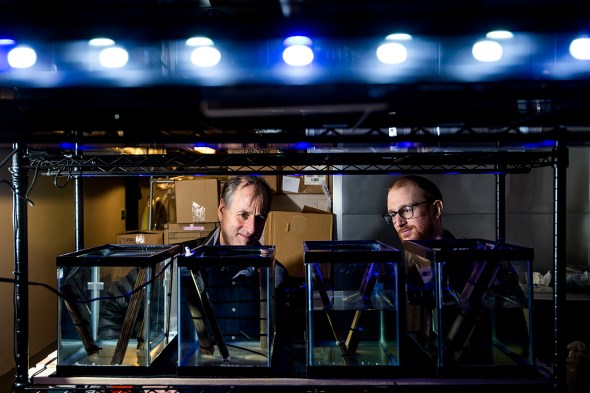This mollusk grows fat on a diet of rock

Kneeling on the banks of the Abatan River on the Philippine Island of Bohol, Reuben Shipway chiseled what appeared to be a translucent sausage out of a chunk of sandstone rock.
The pale, blobby creature was a shipworm, a type of clam that typically burrows into wood by eating it. Shipway, who was a postdoctoral researcher at Northeastern’s Ocean Genome Legacy Center at the time, was holding a species that has evolved to devour themselves a home in rocks instead.

Dan Distel and Reuben Shipway have been studying the bacteria in wood-eating shipworms at Northeastern’s Marine Science Center in Nahant, Massachusetts. Photo by Matthew Modoono/Northeastern University
This rock-eating shipworm was previously known only to the inhabitants of the island. For scientists, it was something totally new.
“It’s almost mythical,” says Shipway, who is the lead author on a new paper describing the creature. “All the other species, for at least some part of their lives, actually require wood.”
What makes this animal unique may also help scientists better understand and improve human health.
Shipway and his fellow researchers are part of the Philippine Mollusk Symbiont project, a collaboration led by universities in the United States and the Philippines to simultaneously document the biodiversity of the islands and search for compounds that could be used in human medicine.
“If you always look in the same place, at the same organisms, you’re going to continue to rediscover the same compounds. But we need new compounds,” says Margo Haygood, a medicinal chemistry professor at the University of Utah who directs the project in the Philippines. “Our new source is these mollusk-associated bacteria, which have been somewhat overlooked until very recently.”
The theory is that bacteria that co-exist inside an organism, known as symbiotic bacteria, will have evolved ways to be useful without accidentally killing the host. If it’s not harmful to a mollusk, it’s less likely to be harmful to a human.
Symbiotic bacteria living in the bodies of typical shipworms help to break down ingested wood into useable sugars. The researchers had been studying the bacteria in wood-eating shipworms to see if any of the chemicals they produce could be used as new antibiotics, or in drugs to fight cancer, HIV, and other human illnesses.
When they spotted a reference to a rock-boring shipworm in a field report from a French biodiversity study, they knew they had to investigate. It took two separate expeditions, but in August of 2018, Shipway and several colleagues from the University of the Philippines found the shipworms burrowing into the rocks along the Abatan.
“We actually got a really good tip-off from one of the locals, who must have been quite bemused by what we were doing,” says Shipway, who is now a postdoctoral researcher at the University of Massachusetts Amherst. “They said, ‘Look in the rocks on the bottom of the river and you’ll be able to find these animals.’”
And find them they did. The shipworms had entirely reshaped the riverbed ecosystem. The rocks at the bottom of the river were covered in holes, many with tiny shipworm siphons protruding into the water. Any burrows the shipworms had abandoned were now home to small fish and crustaceans.
The scientists weren’t surprised to find that the rock-eating shipworms were already well-known to the people in the area, Shipway says. In fact, the locals were eating them.

“This is sort of typical when we go to places and we ‘discover’ these animals,” says Dan Distel, who leads the Northeastern research team and directs the Ocean Genome Legacy Center. “The locals have known about them forever.”
After bringing specimens back to Northeastern’s Marine Science Center in Nahant, Massachusetts, the researchers were able to confirm that the animal is not only a species previously undocumented by scientists, but also a new genus. They named it Lithoredo abatanica.
The discovery came with an entirely new conundrum. Unlike all other known shipworms, it doesn’t eat wood. It is specifically adapted to burrow by scraping at and ingesting rocks.
Most shipworms can survive on a diet of exclusively wood, with the aid of specialized bacteria that help them digest. But rock doesn’t have much nutritional value. And, by shipworm standards, Lithoredo is downright plump.
“We know from previous shipworms that the symbiosis is really important for the nutrition of the animal,” says Shipway. “We’re going to be examining the symbiosis really closely for further clues about how they get their food.”
The bacteria that help this unlikely shipworm thrive in the bedrock at the bottom of a river must be equally unique, to provide nutrients from an unknown source. And they may be able to provide some of the new compounds the researchers have been looking for.
“The symbionts that they have are different from every other shipworm we’ve looked at,” says Distel. “I’d probably say they’re different from any other symbiotic bacteria that we know of.”
For media inquiries, please contact Shannon Nargi at s.nargi@northeastern.edu or 617-373-5718.





